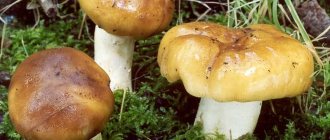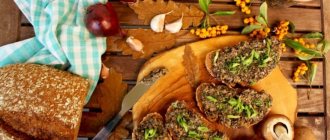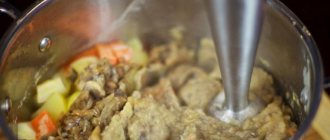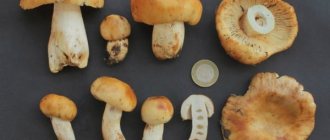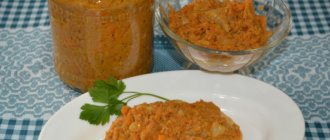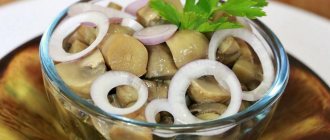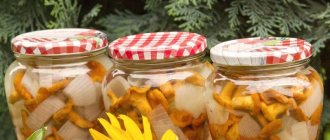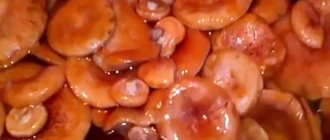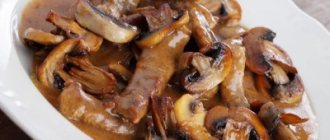Valui, cowsheds, kulbiki, pigs, goby mushroom - what kind of affectionate nicknames does this species have! Lovers of quiet hunting are well aware of the nutritional value of valueu and are happy to collect them in the forest. Find out all the best ways to prepare valuev for the winter - they have been tested by experience and guarantee the preparation of a high-quality, tasty mushroom product.
Beneficial properties of the mushroom and contraindications
It is known that valui belongs to the fourth category of edibility; it is a conditionally edible mushroom.
This means that they cannot be consumed without preliminary processing (soaking, boiling). Fists, or gobies (as valui are also popularly called) can seriously harm your health if these requirements are neglected. Nutritionists classify valui as a dietary product, since 100 grams of mushroom pulp contains only 29 kcal. Despite such a low calorie content, saturation with bulls occurs very quickly and lasts a long time.
Valui have a powerful supply of natural protein and are even able to compete in this sense with meat, fish, and eggs. Protein is known to be the main building material in the body.
Important! Valuis lose moisture when dried, but the volume of protein in them is even higher than in fresh mushrooms.
Gobies are mostly water, about 90%. During heat treatment, it evaporates and only useful microelements and vitamins remain. In addition to protein, fruiting bodies contain amino acids: arginine, leucine, tyrosine. They help digest food by preventing the deposition of cholesterol.
Valui has a good effect on the digestive system and has anti-cancer and anti-inflammatory properties. There is little fat in bulls, and as many carbohydrates as are contained in vegetables.
It is strictly forbidden to use valui for children under 12 years of age, pregnant and lactating women, people with gastrointestinal problems, especially during exacerbations.
Primary preparation
After you have brought a harvest of value from the forest, you need to carefully select them, sort them, and throw away spoiled fruiting bodies. Don’t be lazy and wash each fungus, clean the leg of dirt. If the valui are too dirty, it makes sense to soak them in cold water for a couple of hours to loosen the dirt, and then wash them as usual.
Some mushroom pickers believe that it is necessary to remove the skin and separate the stem from the cap. It’s safe to say that this process will not affect the gastronomic value of the dishes in any way, so whether to clean it or not is a matter of taste. Moreover, whole fruiting bodies look more beautiful in pickles than those divided into parts.
Peeled mushrooms should be placed in a deep container with cold water (if the harvest is large, then a bath or large vat is suitable for this purpose). It is important that the valui are completely submerged in water. Soaking should last 2-3 days, no less, during this period of time bitterness will come out of the fruiting bodies, which will then need to be thoroughly washed off.
What do pigs look like and where to collect them?
There are two main types of these mushrooms:
- The pig is fat. Such mushrooms are most often found on the stumps of coniferous trees. You can start collecting them in the first month of summer. They are characterized by a large cap, the diameter of which can reach 20 cm. As a rule, it has a reddish-brown color. Below you can notice thin plates of a yellowish tint. If the cap is broken, the fracture site begins to darken in the air. The pig's leg is short and dense. Often it has a curved shape. This type of mushroom is still considered inedible, so it is not recommended to eat it.
- The pig is thin. Such mushrooms can be found near spruce, poplar and birch trees. They are characterized by a large fleshy cap, the diameter of which can reach 10 cm. In young mushrooms, the cap has a flat shape. As the mushroom matures, the cap becomes funnel-shaped. The mushroom stem is short and has a lighter color compared to the cap. It is this type of pork that is best suited for marinating at home. The main thing is to choose the right recipe and strictly follow it.
Boil valui
- The next step in how to pickle valui mushrooms for the winter in jars is boiling. It is also impossible to do without this process, although there are different opinions on this matter. But it’s better to play it safe and boil the bull mushroom so as not to spoil the entire pickling.
- After the fruiting bodies have been soaked, you need to rinse them thoroughly under water and place them in a saucepan, where they will continue to cook. Fill the valui with cold water, place the container on the stove and cook until the water boils. As soon as this happens, you need to constantly ensure that foam does not form on the surface, which should be removed using a slotted spoon.
- The first boiling is completed, now you can put the valui in a colander, rinse well and ferment, preserve, pickle, freeze, screw under iron lids, and do any kind of seaming. If you plan to eat bulls now - fry, boil, cook roast, etc., then you need to repeat the boiling process.
Important! For pickling and salting, it is better to choose young mushrooms; they taste better and look more beautiful in pickles. From larger specimens you can make soup, filling for pies and pies, make caviar and pates.
Video
An experienced mushroom picker talks about preparing and marinating barns in the following video:
For several years she worked as a television program editor with leading producers of ornamental plants in Ukraine. At the dacha, of all types of agricultural work, she prefers harvesting, but for this she is ready to regularly weed, pull, shed, water, tie, thin out, etc. I am convinced that the most delicious vegetables and fruits are those grown with your own hands!
Found a mistake? Select the text with the mouse and click:
Natural toxins are found in many plants; Those grown in gardens and vegetable gardens are no exception. Thus, the seeds of apples, apricots, and peaches contain hydrocyanic acid, and the tops and peels of unripe nightshades (potatoes, eggplants, tomatoes) contain solanine. But do not be afraid: their number is too small.
You need to collect medicinal flowers and inflorescences at the very beginning of the flowering period, when the content of nutrients in them is highest. Flowers are supposed to be picked by hand, tearing off the rough stalks. Dry the collected flowers and herbs, scattered in a thin layer, in a cool room at natural temperature without access to direct sunlight.
Oklahoma farmer Carl Burns developed an unusual variety of multi-colored corn called Rainbow Corn. The grains on each cob are of different colors and shades: brown, pink, purple, blue, green, etc. This result was achieved through many years of selecting the most colored ordinary varieties and crossing them.
Both humus and compost are rightfully the basis of organic farming. Their presence in the soil significantly increases the yield and improves the taste of vegetables and fruits. They are very similar in properties and appearance, but they should not be confused. Humus is rotted manure or bird droppings. Compost is rotted organic remains of various origins (spoiled food from the kitchen, tops, weeds, thin twigs). Humus is considered a higher quality fertilizer; compost is more accessible.
In little Denmark, any piece of land is a very expensive pleasure. Therefore, local gardeners have adapted to growing fresh vegetables in buckets, large bags, and foam boxes filled with a special earthen mixture. Such agrotechnical methods make it possible to obtain a harvest even at home.
Tomatoes have no natural protection against late blight. If late blight attacks, any tomatoes (and potatoes too) die, no matter what is said in the description of the varieties (“variety resistant to late blight” is just a marketing ploy).
A new product from American developers is the Tertill robot, which weeds weeds in the garden. The device was invented under the leadership of John Downes (creator of the robot vacuum cleaner) and works autonomously in all weather conditions, moving over uneven surfaces on wheels. At the same time, it cuts off all plants below 3 cm with the built-in trimmer.
From varietal tomatoes you can get “your own” seeds for sowing next year (if you really like the variety). But it is useless to do this with hybrids: you will get seeds, but they will carry the hereditary material not of the plant from which they were taken, but of its numerous “ancestors”.
Humus is rotted manure or bird droppings. It is prepared like this: the manure is piled up in a heap or pile, layered with sawdust, peat and garden soil. The pile is covered with film to stabilize temperature and humidity (this is necessary to increase the activity of microorganisms). The fertilizer “ripens” within 2-5 years, depending on external conditions and the composition of the feedstock. The output is a loose, homogeneous mass with a pleasant smell of fresh earth.
Cold pickling
This recipe for valuev for the winter requires a special approach to canning. After pre-treatment, the mushrooms need to be blanched. This process involves briefly boiling the product in hot water and then quickly cooling. This technological trick allows you to maintain the crunchy texture of the valui and its shape.
Ingredients:
- cowsheds – 4 kg;
- salt – 150 g;
- dill seeds – 1 tbsp;
- cloves – 7-8 buds;
- horseradish (leaves) – 2 pcs.
How to salt valueu mushrooms for the winter step by step:
- Prepare the valuev: soak the fruiting bodies for a day, and then boil for half an hour. Rinse under running water.
- Place the cowtails in a colander and place in a pan of boiling water for 5 minutes.
- Rinse immediately under cold water and place on a sieve to dry thoroughly.
- Place spices and horseradish leaves on the bottom of glass jars.
- Distribute the entire volume of salt over the number of jars and pour a little on the bottom of each.
- Place the bulls in containers, sprinkle with salt and spices.
- Press down the contents of the jars and fill with cold water.
- Cover with nylon lids and place in a cool place.
Preservation of salted valuuy
Salting valueu mushrooms in jars for the winter allows you to immediately prepare a large amount of preserved food. It is worth noting that this method involves storing the seams in a cool place, so before you pickle mushrooms, you need to immediately take care of such a place.
Ingredients:
- cowsheds – 1 kg;
- allspice – 3 pcs.;
- salt – 50 g;
- garlic – 3 cloves;
- bay leaf – 2 pcs.;
- sugar – 20 g;
- dill umbrellas – 2 pcs.
How to prepare valui mushrooms for the winter:
- Wash the mushrooms, remove the skin from the caps, and remove any forest debris.
- Boil the barnacles for half an hour in salted water.
- Place the fruiting bodies in a large container, sprinkling each layer with salt, sugar, spices, and chopped garlic.
- Place pressure on top. Mushrooms should be completely immersed in brine.
- During salting, foam will form, which must be skimmed and removed.
- After 10–14 days, you need to put the mushrooms in clean jars, sprinkle with dill umbrellas and fresh slices of garlic.
- The cowsheds need to be laid very tightly and covered with lids.
Important! In order for the valui to be better preserved in jars and the surface of the mushrooms not to sour, you need to grease the back of the lids with mustard.
Preparing the main ingredient
Like all milk mushrooms, nigella and svinushki require preliminary cleaning of sticky caps from twigs and other forest debris. For these purposes, it is enough to rinse them under running water and simply remove all dirt with a brush. The knife is used only for trimming the legs and cutting out areas with rot or damaged parts.
The next stage is soaking the bitterness contained in the mushroom juice. To do this, they are placed in a large container, filled with water, and the layer of mushrooms on top is pressed down lightly with pressure so that the nigella and pig mushrooms are completely hidden under the layer of water. The water will need to be changed at least 3-4 times a day and bathing for 72 hours.
Blanching the fungi in boiling water followed by cooling under running water will help speed up the process, but this speed leads to the loss of the main thing - the crispy quality of such pickles.
Freezing
The goby mushroom can be frozen for the winter. This is what zealous housewives often do to take a portion of mushrooms out of the freezer during the cold season and cook a delicious soup, use them to prepare stews, stir-fries, or simply fry them with sour cream and onions in tomato sauce.
To freeze valui for the winter, you need to follow all the preliminary preparation processes: soak, boil the fruiting bodies. Then you should definitely drain the fruits in a colander so that no excess moisture remains. Cut the bulls into cubes or in any convenient way, place them in special containers or plastic bags and place them in the freezer.
Important! Frozen valui can be stored for up to six months. They cannot be re-frozen, so it is more convenient to store them in portions, 100–200 grams in one container.
Is it possible?
RESULTS евÑннÑÑ Ð±Ð¾ÑкÑ, еÑли ÑвинÑÑек оÑÐµÐ½Ñ Ð¼Ð½Ð¾Ð³Ð¾. RESULTS, RESULTS ·return "Responsiveness" RESULTS, RESULTS виÑÑ Ð»Ð¸ÑÑÑÑ Ð²Ð¸Ñни и ÑÑена. RESULTS ½ÑÑ Ð²Ð¾Ð´Ñ, Ñак как ÑаÑÑоД бÑÐ´ÐµÑ RESULTS.
RESULTS, RESEARCH RESULTS ´ÑÑиÑÑÑй. RESULTS. RESULTS OPTIONAL RESEARCH п ла. RESULTS ва ÑилÑно иÑп¾ÑÑÑÑÑÑÑ, а ÑаÑÑол закиÑнеÑ.
Cold pickled mushrooms without vinegar
The only significant difference between pickling mushrooms and cold or hot pickling is the fact that leaven (whey) is added to the valui. Low-fat kefir is sometimes used as a fermentation product, but this is a matter of taste.
Ingredients:
- valui – 2 kg;
- salt – 140 g;
- sugar – 30–40 g;
- spices to taste: horseradish, allspice and dill seeds, cumin, cinnamon or ginger.
Valui pickled for the winter in jars:
- Soak and boil the valui once in salted water (proportion: 20 g of salt per 1 liter of water). Boiling should take 20-30 minutes.
- Prepare the starter: to do this, dissolve salt and sugar in boiled water, add whey, stir well.
- Place washed, boiled valui in layers in a wooden barrel or enamel pan and fill with sourdough.
- Place a bend on top. Place the container in a place where a constant temperature of 5–10 C is maintained, this is important for a successful fermentation process.
- After this time, move the pan to the cellar for ripening. This will take 30–40 days.
- The fermented valui must be placed in jars, filled with boiled brine and sealed.
Important! 40 days after fermentation, lactic acid continues to form in the brine, and the mushrooms will become more and more sour. It is very important to stop this process in time. That is why you need to put the mushrooms in jars and seal them.
Mushroom barn - how to properly prepare cow lip?
Despite all the precautions for consuming pigs and warnings from doctors about their toxic properties, many mushroom pickers collect barn mushrooms, prepare them for the winter, fry them, boil them and eat them. You just need to know that if a person has diseases such as psoriasis, eczema, allergies, it’s better not to eat them, just cross them off the menu so as not to harm your body.
Barn preparation methods
So, if there are no contraindications to consuming barnyard mushroom, then before you start cooking the mushroom, you will need to take preparatory measures and properly process the product.
- To do this, first wash the mushrooms and remove all dust and dirt from the food.
- Soak them thoroughly. Dissolve salt in water (proportion: per 1 liter of water, 2 teaspoons of salt).
- Soak the mushrooms in this saline solution twice, the total time for the procedure is five to six hours.
- Then you can start boiling the barn. Mushrooms should be cooked about three times.
- Moreover, the proportions of water and mushrooms are 1 to 1. And the salt is sprinkled to taste.
- Boil the mushrooms for five minutes the first time, fifteen minutes the second time, change the water the third time and boil the mushrooms for 30-40 minutes.
How to cook barn mushroom?
IMPORTANT : The cowberry mushroom can be found in small clearings in the forest that are well lit. These mushrooms are ideally suited for culinary purposes, and it is better not to collect thin-legged pig mushrooms that grow near roads. They may contain harmful components that cause all sorts of poisoning.
It is better to process and cook mushrooms immediately after collecting them. Otherwise, they may simply disappear, become moldy, turn black, etc. And their processing requires compliance with the rules already mentioned above. Drying the barn is not recommended. If you want to make preparations for the winter, you can pickle or marinate mushrooms. Containers made of glass, wood, ceramics, etc. can be used as containers.
Fried dumplings in glass jars
Such preparation will not only preserve the value harvest for the winter, but will also save the housewife’s time on preparing dishes, since the semi-finished mushroom product will always be at hand. Please note that
that for better preservation, the jars can be closed with nylon lids and stored in the refrigerator or sealed with metal ones and sterilized for a long time.
Ingredients:
- dumplings – 2 kg;
- vegetable oil – 100 ml;
- salt - to taste.
How to make fried valui for the winter, description of the step-by-step process:
- Peel, soak and boil the valui twice.
- Cut them into small pieces. Small specimens can be left whole or simply cut lengthwise into two parts.
- Place the mushrooms in a sieve or colander to drain.
- Pour oil into a frying pan and heat it.
- Place the dumplings in a container and fry them with the lid closed for 45 minutes, stirring constantly.
- Remove the lid and let the moisture evaporate.
- Add some salt. Place the entire portion of the dumplings into clean jars.
- Pour in boiling oil.
- Close the jars with nylon lids or cover them with metal ones, place them in a container with boiling water and sterilize each jar over low heat for 15 minutes.
- Cool the containers and store them in the basement.
Important! Hot vegetable oil should completely cover the contents of the jars. If it is not enough, you need to take another portion of oil, heat it and add to the required volume in the container with the barns.
How poisonous
Once upon a time, the cowshed was listed in reference books as a conditionally edible mushroom. But in the early 80s, mycological scientists “demoted” it and classified it as inedible, and by 2006 it became not just inedible, but dangerously poisonous.
Researchers have discovered that the pig has several features that make it completely unsuitable for human consumption:
- Muscarine is a poison that is contained by bright representatives of inedible mushrooms - red fly agarics. It is not exposed to high temperatures: even three hours of cooking will not kill it.
- Lectin is a substance that is very dangerous for humans. An antidote against this poison has not yet been invented.
- Svinushka is a powerful environmental filter, a sorbent that actively absorbs heavy metals and other harmful substances. Their concentration can be more than 800 times higher than the concentration in the environment.
- High concentration of antigen protein. It attacks red blood cells - red blood cells, causing them irreversible damage and making them a target for antibodies. As a result, when it accumulates in the human body, the immune system malfunctions: it attacks its own red blood cells and destroys them. The sad result of the meal can be immediate blood clotting. The antigen protein can accumulate for many years in the body of those who like to enjoy a pig dish from time to time. This leads to anemia, thrombosis and other diseases and disasters - for example, heart attack, stroke, pulmonary vein thrombosis. There is an opinion that only one percent of the population is exposed to such deadly effects of harmful substances. It might seem like a small number, but it is not known who is included in this risk group.
IMPORTANT! There are no safe recipes for cooking and canning barn food. Neither soaking nor prolonged boiling will remove toxins and other harmful substances from it.
A simple recipe for mushroom caviar for the winter
Valui is perfect as a base for such a savory and appetizing dish. Mushroom caviar from Valuev for the winter: the recipes contain a lot of vegetables, spices, garlic, and other ingredients that will highlight the taste of the dumplings. Try preparing a snack for future use from the following ingredients.
Ingredients:
- valui – 1 kg;
- onion – 250 g;
- carrot – 1 pc.;
- garlic -6 cloves;
- vinegar - 1 tbsp. l.;
- vegetable oil – 50 ml;
- salt – 30 g;
- bay leaf – 2 pcs.;
- black pepper - to taste.
Valui - caviar for the winter:
- Soak the fists and boil for half an hour in salted water. Repeat boiling again.
- Place the fruiting bodies in a colander or sieve and let the water drain.
- Pass the valui through a meat grinder.
- Peel the vegetables. Cut the onion into cubes, grate the carrots.
- Stew the vegetables in vegetable oil until soft, and also pass through a meat grinder.
- Mix all ingredients, add salt and season the caviar with spices.
- Stir and place in the same pan in which the vegetables were stewed.
- Cover the container with a lid and simmer for another 15 minutes over low heat.
- Finally, pour in the vinegar.
- Place hot caviar into jars and screw on the lids.
Important! This canned caviar cannot be stored in an apartment at room temperature. Workpieces should be stored in a cellar or basement, in a cold place.
Preparing for winter with aspirin
Cowtails marinated in boiling broth turn out to be very soft, but the caps and legs remain elastic and intact. Such an unusual component as aspirin acts as a preservative and prevents the development of pathogenic bacteria.
Ingredients:
- cowsheds – 1 kg;
- bay leaf -2 pcs.;
- garlic – 2 cloves;
- dill - 1 umbrella;
- black pepper – 5 pcs.;
- salt – 100 g;
- water – 1l;
- aspirin – 1 tablet.
How to prepare valui for the winter using aspirin:
- Thoroughly rinse pre-soaked and boiled mushrooms.
- Pour water into a container, dissolve salt in it, and bring to a boil.
- Immerse the cowsheds in the pan and cook for half an hour from the moment the water boils.
- Add bay leaf.
- Place slices of garlic, other spices and aspirin in clean jars.
- Place hot bull mushrooms in jars and fill with hot brine.
- All that remains is to roll up the cans.
Sequencing:
- Wash the product, remove moss, leaves and other vegetation and soak for 12-14 hours, changing the water every hour.
- Boil in water three times for 40 minutes, rinsing and draining using a colander.
- Prepare a marinade from 1 liter of water, 100 g of salt, 25 g of sugar, 2 bay leaves and 10 peppercorns. Bring everything to a boil and place the pork in the marinade.
- 15 minutes after the start of boiling, add 125 g of vinegar and boil for another 5 minutes.
The result is marinated spicy pork mushrooms with vinegar; they need to be placed in prepared jars and rolled up.
After cooling, store in a cool place.
Secrets, spices, additives...
Many housewives try very hard to make the waluis crispy for the winter. To do this, you need to know some tricks: use oak or currant leaves when pickling - these seasonings are added when pickling cucumbers to preserve their crispness. Marinated mushrooms also turn out crispy if all stages of preparation are followed correctly.
Spices that are used when salting and marinating kulbiks: black pepper and allspice, mustard seeds, coriander, cinnamon, ginger, cherry and raspberry leaves, umbrellas and sprigs of dill, cloves, thyme, garlic (dry and fresh), bay leaf.
If the pickled valui is rolled up with airtight lids in glass jars, it is easy to ensure safe storage conditions. It is enough to put the pickles in the pantry or even under the bed. The main thing is that this place should not be exposed to direct sunlight, and the storage areas should not be in close proximity to heating appliances and household appliances.
In the case where salted barns are stored in barrels or enamel containers, you need to constantly check their consistency and ensure that mold and foam do not form, which should be promptly removed. Gauze or fabric pads between the oppression and the pickle must be periodically changed, washed or disinfected.
Preparing valui for the winter in any form (salted, fried, pickled, pickled) is not at all difficult. You need to master the basic principles of these processes and strictly follow the cooking technology. Fragrant, spicy, elastic bulls will certainly delight you and your whole family with their taste and appearance!
About the benefits, calories and value of values
The benefit of Valuev lies primarily in a large amount of protein, which is an indispensable component of the body’s vital functions. Scientists say that in barns this figure is twice as high as in meat and eggs.
In addition, vitamins and other valuable microelements in valui have the following beneficial properties:
- help reduce blood sugar levels;
- normalize heart rate and blood pressure;
- actively participate in the processes of hematopoiesis and metabolism;
- have antioxidant, immunostimulating, anti-inflammatory properties.
The caloric content of value mushroom is 29 kcal per 100 grams of product.
The chemical composition of value mushrooms includes: vitamins A, B1, B2, B5, B6, B9, D and PP, as well as beneficial minerals such as potassium, calcium, copper and manganese, iron, aluminum, phosphorus and sodium.
Important! Kulbiki contain a substance such as chitin. It is very difficult for the body to digest, so eating these mushrooms in large quantities is contraindicated.
